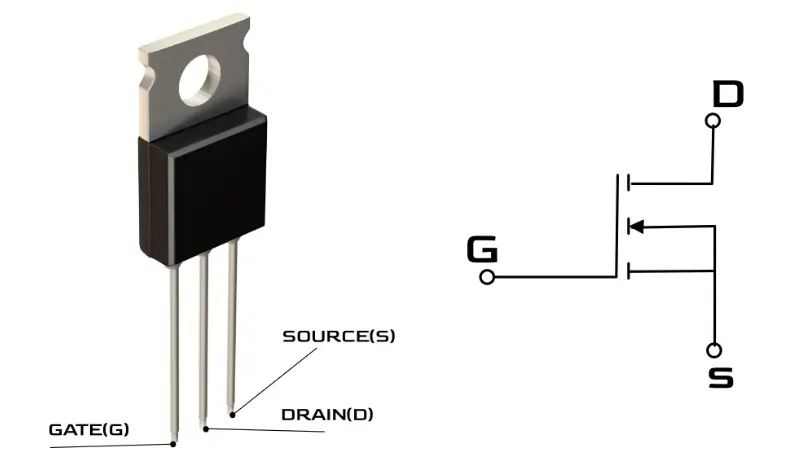A MOSFET (Metal Oxide Semiconductor Field Effect Transistor) is a crucial electronic device used to control the flow of electrical current in circuits. Known for its efficiency and reliability, the MOSFET operates by regulating the movement of electrons through a semiconductor material. Due to its ability to handle high-speed operations and low power consumption, it plays a vital role in various electronic applications, from amplifiers to switching devices. There are two main types of MOSFETs: enhancement mode and depletion-mode, each serving different functions in modern electronics.
Have you ever thought about controlling current? Some might be wondering, can current really be controlled? Yes, of course, current can be controlled. Today we will discuss a device that can control current by itself. The name of this device is “MOSFET.”

So, let’s learn some known and unknown facts about MOSFET. MOSFET stands for Metal Oxide Semiconductor Field Effect Transistor. It is an electronic device that can control the flow of electrons by itself. This is why it is also referred to as an Active Device.
Now, let’s get to know the device a little better. Devices are generally categorized into two types:
1) Active Device 2) Passive Device
1) Active Device: Devices that can control the flow of electrons, i.e., the flow of current, by themselves are called active devices. Examples include BJT, JFET, MOSFET, etc.
2) Passive Device: Devices that cannot control the flow of electrons or current by themselves are called passive devices. Examples include diodes, capacitors, transformers, etc.
MOSFET is mainly divided into two types: 1) Depletion-type MOSFET, 2) Enhancement-type MOSFET.
Depletion-type and enhancement-type MOSFETs are almost the same, with one major difference. In depletion-type MOSFET, there is initially a channel between the drain and source. However, in enhancement-type MOSFET, there is no initial channel between the drain and source, and a channel must be created.
We mainly use enhancement-type MOSFETs. Therefore, we will discuss enhancement-type MOSFETs below.
Enhancement-type MOSFET is divided into two types: 1) n-channel enhancement-type MOSFET, 2) p-channel enhancement-type MOSFET.
Let’s see how an n-channel enhancement-type MOSFET is created. MOSFETs generally have three terminals:
They are:
- Source
- Drain
- And the most important, the Gate.
First, a semiconductor is taken. Then, through a specific process, the semiconductor is doped with holes, turning it into a p-type semiconductor. This is called the substrate or body. Then, two n-type walls are created on either side of the body by electron doping (see the diagram).

The first n-type wall is called the source, and the second n-type wall is called the drain. A thin metal layer is applied between the drain and source. The area between the source and drain is called the gate.
A thin oxide layer (usually silicon dioxide) is placed above the gate, and another metal layer is placed on top of the oxide layer. A terminal is drawn from each, resulting in four terminals.
In practice, most of the time, the source and drain terminals are shorted. This is why it is said that MOSFET primarily has three terminals.
How does a MOSFET work?
In the case of an N-type: First, the positive terminal of the voltage source is connected to the gate terminal, and the negative terminal is connected to the body/source terminal.
The positive terminal of the battery pushes the holes in the gate downward and pulls the electrons upward, resulting in the formation of a path or channel of electrons between the drain and source.

If a higher voltage is applied to the gate terminal, more electrons will accumulate, and the channel will widen. If lower voltage is applied, fewer electrons will accumulate, narrowing the channel.
Now, a voltage source is connected between the drain and source terminals, causing current to flow between the source and drain.
If positive voltage had not been applied to the gate terminal, there would be no electrons between the drain and source, and thus no current would flow. The more electrons there are between the drain and source, the more current will flow.
By increasing or decreasing the gate voltage, more or fewer electrons accumulate in the channel, resulting in more or less current flow.
1. What is the principle of a MOSFET?
A MOSFET operates by controlling the voltage applied to its gate terminal, which in turn regulates the flow of current between the drain and source terminals. The gate voltage creates an electric field that modulates the conductivity of the semiconductor channel, allowing or blocking current flow.
2. What is a MOSFET vs transistor?
A MOSFET is a type of field-effect transistor (FET), whereas a traditional transistor refers to a bipolar junction transistor (BJT). The key difference is that MOSFETs are controlled by voltage, while BJTs are controlled by current. MOSFETs are preferred for high-speed switching and low-power operations, while BJTs are used for amplification.
3. Why is MOSFET used as a switch?
MOSFETs are used as switches because they can operate efficiently at high speeds and consume minimal power. They offer rapid switching between on and off states, making them ideal for applications like power supplies and motor controllers.
4. Why is e-MOSFET used?
Enhancement-mode MOSFET (e-MOSFET) is commonly used because it requires a positive gate voltage to conduct, making it easier to control in various digital and analog circuits. It offers better efficiency and reduced power losses.
5. Which MOSFET is mostly used?
The n-channel enhancement-mode MOSFET is the most commonly used type due to its high efficiency, fast switching capabilities, and widespread applications in both analog and digital circuits.
6. What are the applications of MOSFET?
MOSFETs are widely used in power electronics, amplifiers, switching circuits, motor drivers, and voltage regulators. They are also integral in digital circuits, RF devices, and computer processors.
7. What is the advantage of MOSFET?
The main advantage of MOSFETs is their high-speed switching, low power consumption, and ability to handle high currents. They offer better efficiency compared to BJTs and are ideal for modern electronic devices due to their compact size and reliability.



